For months, I’d planned on showing a small hinoki in Bay Island Bonsai’s 13th annual exhibit. The hinoki’s health took a turn for the worse and I found myself with a few weeks to prepare another tree for exhibit. I selected a deciduous tree for the exhibit – a root over rock trident maple. I last showed the tree in 2010 in a cream colored oval pot made by Sara Rayner. It was time for a change.
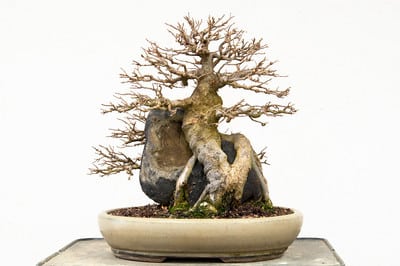
Trident maple – Sara Rayner pot
I brought the tree and a number of candidate pots to a Bay Island Bonsai workshop for repotting. Before selecting a new pot, I removed the tree from the pot and worked on the roots. For a complete description of the repotting process, see the series of posts beginning with”Repotting a trident maple.”
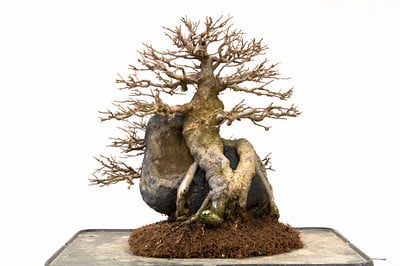
Ready for a new pot
Selecting bonsai pots for show trees is a favorite activity of mine (see “Pot selection redux” for a similar exercise with a small black pine). Here were my options.
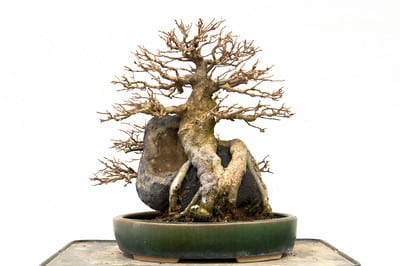
Option #1 – Old Chinese pot
I don’t typically associate trident maples with green pots, but I happened to have several that were the right size. The above oval pot was made in China. It’s about the right size and shape for the maple, but it didn’t strike me as an interesting match.
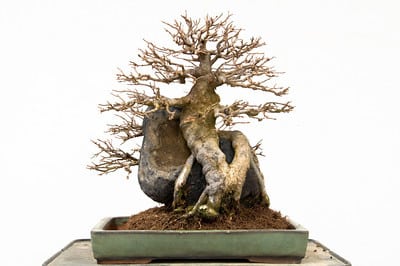
Option #2 – Old Chinese pot
The next pot I tried was also Chinese. It’s the right size, but very shallow. Not surprisingly, the pot makes the tree look taller.
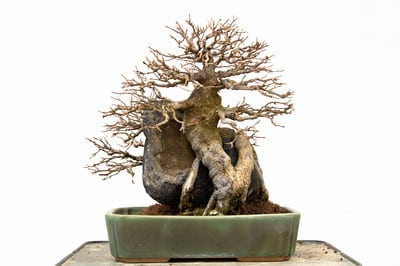
Option #3 – Japanese pot
This Japanese pot above is much newer than the two Chinese pots. It’s a good size for the tree, but it lacks the character of the older pots.
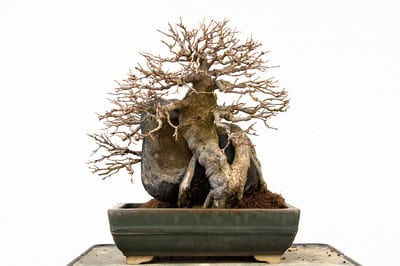
Option #4 – Sakura pot
The fourth option is a slightly darker green. The curved sides didn’t look right to me and the pot seemed a little on the big side. Next!
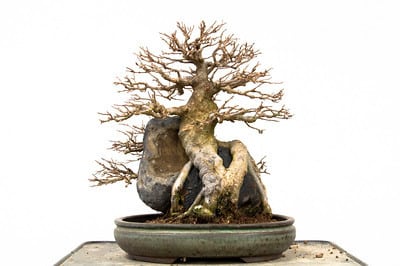
Option #5 – Sara Rayner
The fifth pot I looked at is another Sara Rayner pot. A bit on the small side, this pot seemed to bring out the dullness of the stone. Ideally I would like a pot that brightens the composition, but for some reason most of my small, shallow pots are shades of green.
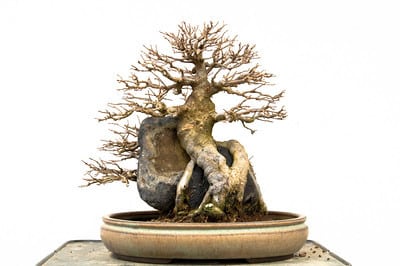
Option #6 – Sara Rayner
The sixth pot was also from Sara Rayner. The size and shape are appropriate, but I found the stripe formed by the lip to be very strong.
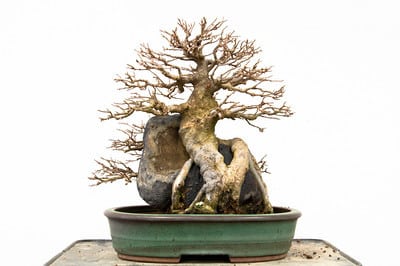
Option #7 – Michael Hagedorn
The seventh pot was made by Michael Hagedorn. It’s a very useful pot. One side is a light shade of green. The other side is a darker green.
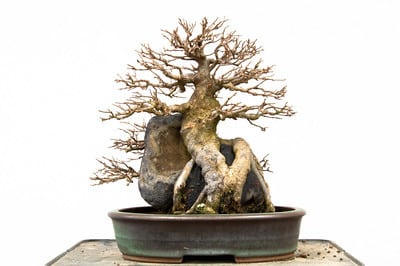
Option #8 – Michael Hagedorn
The pot is a bit deep for the tree. I think it would look best when the leaves turn color in the fall, but like the other dark-colored pots above, it brings out the darkness of the stone.
I think all of the pots are acceptable for exhibit, but some are better matched to the tree than others. I decided to go with the oldest looking pot, which happened to be the pot with the most interesting shape – the warped, old Chinese pot. Here are some close ups.
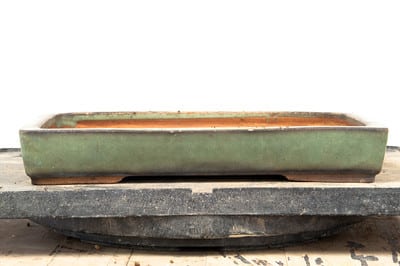
Old Chinese pot
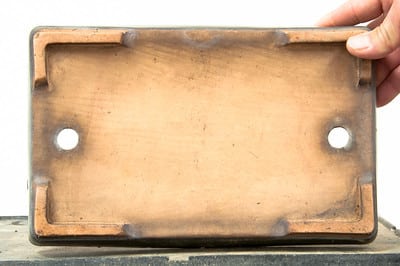
From below – no chop
I fit what roots I could in the pot and the rest sat above the rim.
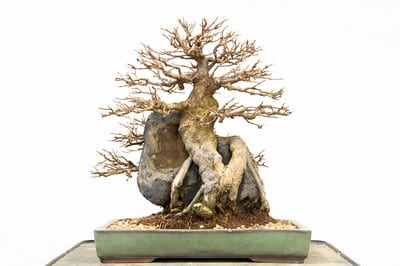
Repotting complete
To dress it up for the exhibit, I placed moss on the surface of the soil (see “Moss technique” for details).
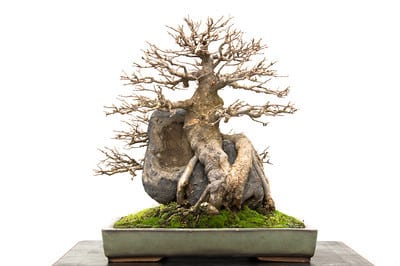
All mossed up – as shown in BIB’s 13th annual exhibit
Because this tree is on the small side, I showed it with another tree, a Japanese black pine I grew from seed. The display would have better balanced were there a greater difference in size between the two trees, but I didn’t have another tree to accompany the maple.
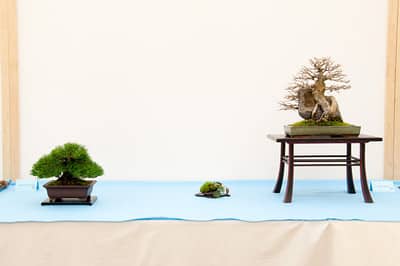
Medium display – shohin black pine and chuhin trident maple
The old Chinese pot was good for the show, but it was a bit shallow for a growing pot. Not long after the exhibit I repotted it in a slightly larger pot. Which one? Pot number 3.
Subscribe to Bonsai Tonight
New Posts Delivered Every Tuesday and Friday
tmmason10 says
Interesting that you have a lot of pots with such a similar shade. How old is the JBP? I am using your guides to try them from seed this spring.
Jonas Dupuich says
The pine is 18 this year – best of luck with your seeds!
yenling29 says
Great Post! I really like the old Chinese pot you selected.
Daniel Dolan says
Jonas:
You mentioned your Hinoki……..as I have a fairly good sized one and it represents a not insignificant investment I am curious about the health issue you referred to.
As your experience and abilities are much greater than my own……what happened.
Always looking to develop my Hinoki knowledge.
Best regards,
D/D
Jonas Dupuich says
Hi Daniel – the bottom line is, don’t leave home for two months. When I returned from my trip to Japan, the tree was in rough shape (all of my other trees were fine). I don’t yet know if fungus, disease, root rot, or insects are to blame. My guess is that the tree dried out and became susceptible to one of the above maladies. I’ll be sure to report any findings if I can figure it out. Thanks for asking!
Scott Roxburgh says
Interesting that you have so many green pots, you don’t really notice that sort of thing until line them up for use in this sort of exercise.
I know that I have bought a pot that I loved, only to get home and realise that I had much the same one already under the benches!
I like the feeling of the 1st chinese pot, however I don’t think the feet work well. I like option 3 the best, I think that it is interesting how slight change in colour/shape can completely change the feeling of the display.
I really enjoy reading these posts thanks Jonas
Scott.
tmmason10 says
Hey Jonas,
As I mentioned I am trying JBP from seed, but was also trying to give trident maple a try too. Have you trie before? Haven’t found any good resources for what soil to use and whatnot. Anyway, love the blog and look forward to all the posts.
Jonas Dupuich says
Hi Tom – I haven’t tried tridents from seed but I’ve grown them in the ground. I use regular bonsai soil for all varieties of seeds, with a layer of sand on top to keep them moist while germinating. As Boon pointed out at our BIB meeting last night, Bonsai Today #23 and #32 have good articles on developing Trident maple bonsai – check them out if you can find copies.